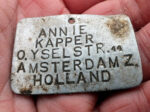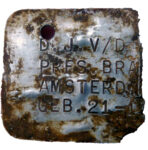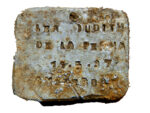 Excavations of the extermination camp of Sobibor in Poland have uncovered four id tags of Jewish children slaughtered there. All four of them were from Amsterdam, part of the targeted extermination of Dutch Jews in spring and summer of 1943. They were:
Excavations of the extermination camp of Sobibor in Poland have uncovered four id tags of Jewish children slaughtered there. All four of them were from Amsterdam, part of the targeted extermination of Dutch Jews in spring and summer of 1943. They were:
- Annie Kapper, born January 9, 1931, murdered April 2, 1943,
- David Juda Van der Velde, born November 21, 1932, murdered April 2, 1943,
- David “Deddie” Jacob Zak born February 23, 1935, murdered June 1943,
- Lea Judith de la Penha, born May 11, 1937, murdered July 1943.
 Annie Kapper was the oldest of the four. Born in January 1931, she was all of 12 years old when she was sent to Sobibor with her family on March 30, 1943. The trains arrived on April 2nd and all 1255 Jews on board were sent to the gas chambers. Her aluminum tag was discovered near one of the camp’s mass graves.
Annie Kapper was the oldest of the four. Born in January 1931, she was all of 12 years old when she was sent to Sobibor with her family on March 30, 1943. The trains arrived on April 2nd and all 1255 Jews on board were sent to the gas chambers. Her aluminum tag was discovered near one of the camp’s mass graves.
 David Yehuda Van der Velde was part of the same transport as Annie Kapper. He was 11 years old when he and his family were deported from Camp Westerbork to Sobibor on March 30th and gassed to death on April 2nd. His aluminum tag, the right side broken off, was discovered just west of the gas chambers.
David Yehuda Van der Velde was part of the same transport as Annie Kapper. He was 11 years old when he and his family were deported from Camp Westerbork to Sobibor on March 30th and gassed to death on April 2nd. His aluminum tag, the right side broken off, was discovered just west of the gas chambers.
Deddie Zak’s tag was found at the site of one of Sobibor’s crematoria. Heartbreakingly, the tag had been burned. Deddie had been imprisoned at  Camp Vught, a concentration camp in the southern Netherlands, and was part of the mass deportation of Jewish children from Camp Vught to the transit camp at Westerbork on June 6th and 7th, 1943. More than 1,000 children from age 0 to 16 were transported to their deaths, including 119 small infants, 55 babies and 123 toddlers. On June 8th, they were loaded onto freight trains and sent to Sobibor. They were gassed to death immediately upon arrival on June 11th.
Camp Vught, a concentration camp in the southern Netherlands, and was part of the mass deportation of Jewish children from Camp Vught to the transit camp at Westerbork on June 6th and 7th, 1943. More than 1,000 children from age 0 to 16 were transported to their deaths, including 119 small infants, 55 babies and 123 toddlers. On June 8th, they were loaded onto freight trains and sent to Sobibor. They were gassed to death immediately upon arrival on June 11th.
 Lea Judith de la Penha, her mother Judith and father David were arrested and held in Westerbork in July 1943. On July 6th, they were deported to Sobibor in a transport of 2,417 Jews. They arrived on July 9th. Mother, father and little girl were murdered that day. She was six years old. Her tag was found near the camp’s railway platform.
Lea Judith de la Penha, her mother Judith and father David were arrested and held in Westerbork in July 1943. On July 6th, they were deported to Sobibor in a transport of 2,417 Jews. They arrived on July 9th. Mother, father and little girl were murdered that day. She was six years old. Her tag was found near the camp’s railway platform.
Yoram Haimi [of the Israeli Antiquities Authority[said: “As far as we know, identity tags with children’s names have only been found at Sobibor, and nowhere else. Since the tags are very different from each other, it is evident that this was probably not some organised effort. The children’s identity tags were prepared by their parents, who were probably desperate to ensure that the children’s relatives could be located in the chaos of the Second World War. Lea, Annie and Deddie’s tags have enabled us to link faces and stories to the names, which until now had only been anonymous entries in Nazi lists. Archaeological excavation provides us with an opportunity to tell the victims’ stories and to honour their memory.”
 Researchers were able to trace the childrens’ final movements because they were all sent to Camp Westerbork before their final deportation to Sobibor. Today the Herinneringscentrum Kamp Westerbork is a memorial center dedicated to the 102,000 people who were imprisoned there. Records of the four children, their happy pasts, their tragic ends, were found in the center’s archives.
Researchers were able to trace the childrens’ final movements because they were all sent to Camp Westerbork before their final deportation to Sobibor. Today the Herinneringscentrum Kamp Westerbork is a memorial center dedicated to the 102,000 people who were imprisoned there. Records of the four children, their happy pasts, their tragic ends, were found in the center’s archives.
Mr Haimi recalled: “I have been excavating at Sobibor for ten years, but this is the hardest day I have ever had. As we stood holding the tags in the field, beside the crematoria, we contacted the centre and we gave them the names. They responded immediately. By phone, we received photos of smiling young children. The hardest thing was to learn that some of the children whose tags we held in our hands reached Sobibor on a children’s transport– 1,300 little children, aged four to eight, who were sent here to die alone, without their parents. I looked at the photos and asked myself, how could anyone have been so cruel?”